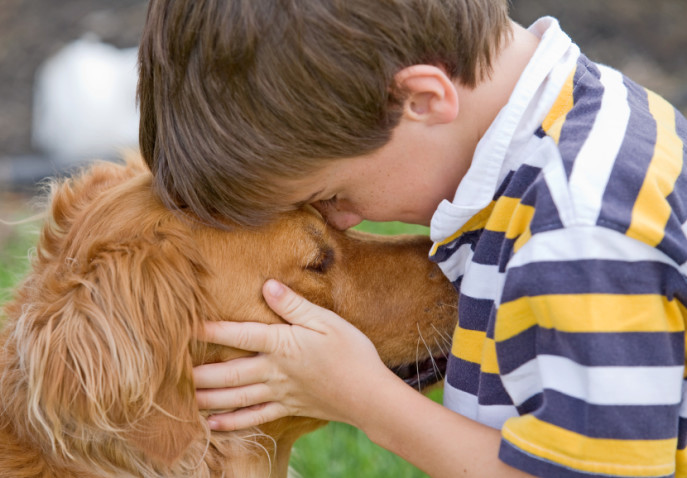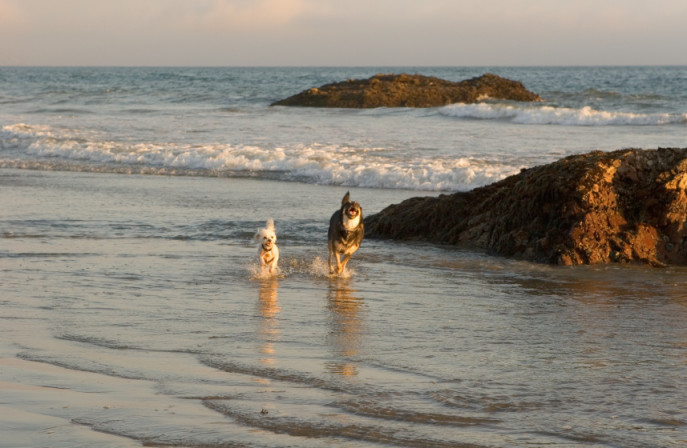
Spring brings warmer weather, and with it, the re-emergence of our pets’ worst tormentors: fleas and ticks. Pet owners can spend more than $200 per year per pet on flea shampoos, flea collars, and topical flea and tick controls. The hidden cost isn’t in the damage to your bank account, however, but the potential damage to your pet’s health.
The Humane Society of the United States has added its voice to the The Center for Public Integrity (CPI) and the Environmental Protection Agency (EPA) in warning that some flea and tick products contain chemicals, specifically permethrins, that not only can cause the death of your dog or cat, but are likely to be carcinogenic to humans.
At least 1,600 pet deaths related to spot on treatments with pyrethroids were reported to the EPA over the last five years. They account for more than half of major pesticide pet reactions, including brain damage, heart attacks and violent seizures.

The Natural Resource Defense Council (NRDC) has a report entitled Poisons on Pets that details the risks to both pets and children. Because children’s bodies are still developing, they are more sensitive to the effects of toxic chemicals than adults. Toddlers’ hand to mouth behavior makes it easy for toxins to be ingested, for example, and children spend time where toxins from pet products tend to accumulate: crawling on rugs, playing with pet toys and holding their much loved pet dog or cat.
As bad as the products are for people, they’re worse for pets. The NRDC says that based on the available data, hundreds and probably thousands of pets have been injured or killed through exposure to pesticides. Just like small children, pets can’t tell us when they’re being poisoned at low doses.

Flea control products on the market include seven specific organophosphate insecticides (OPs). OPs work by blocking the breakdown of the body’s messenger chemical, acetylcholine, and interfering with the transmission of nerve signals in the brains and nervous systems of insects, pets and humans. In the presence of OPs, acetylcholine builds up in the body. The resulting interference with nerve transmissions is of such a magnitude that it actually kills insects. But even at normal doses, it can also harm pets and children (from the NRDC’s Poisons on Pets.)
The seven OPs are chlorpyrifos, dichlorvos, phosmet, naled, tetrachlorvinphos, diazinon and malathion. Another commonly used pesticide in a popular topically applied product is fipronil. According to Virginia Dobozy, a veterinarian at the EPA, fipronil products are classified as carcinogens, producing malignant as well as benign tumors in laboratory tests. Exposure to these insecticides can more than double the risk of Parkinson’s later in life. For pregnant women exposed to pesticides, their children were 250% more likely to be diagnosed with brain cancer before their fifth birthday.

We want to believe that all of the products available for sale have been tested and proven safe. But that’s just not so. According to the CPI, “The EPA cannot make its own assessment because unlike the regulations directing the FDA’s approval of human products, the Federal Insecticide, Fungicide and Rodenticide Act does not require pet products to undergo field trials prior to approval.”
What should you do instead? There is no question that ticks carry dangerous diseases that are transmitted to humans, including Lyme Disease, Rocky Mountain Spotted Fever, Babesiosis, Ehrlichiosis, and Tickborne relapsing fever (TBRF), among others.Some of these are transmitted by ticks in their nymph stage, or even at full grown size, but are no larger than a poppy seed. Here are some of the non-toxic alternatives available:
- Earth Animal, a holistic pet care retail store and website begun by a veterinarian and his wife, offers a natural flea and tick prevention program that is based on adding powder and drops to your animal’s daily diet. A combination of vitamins, minerals and herbs helps to change the odor of the pet’s blood chemistry, so fleas, ticks, mosquitos and black flies do not like either the odor or taste of the blood. The odor is undetectable by humans. During the flea and tick season, you can mist your dog’s belly, paws and coat daily with an organic bug spray to help repel insects.
- Another safe, environmentally friendly product I use is Damminix Tick Tubes. Since Lyme Disease begins with mice, not deer, Tick Tubes rely on the natural nesting instincts of mice to fight the battle. Placed on your property in areas where mice frolic, the biodegradable, cardboard tubes are filled with permethrin treated cotton balls. Mice collect the cotton to build nests in their burrows. Young ticks feeding on the mice are killed by the mild insecticide before they can spread Lyme Disease to you and your family. It is important to use this only on the perimeter of your property, in safe places that are not accessible to pets or children. Even mild insecticides are poisons, and must be used carefully and responsibly.
- I use organic cedar mulch as another layer of protection in my garden beds. It’s a natural pest repellent, but does not harm beneficial insects such as butterflies and bees. You can even place a small amount in an open container in your pantry or closets for a pleasant cedar aroma that will deter indoor pests.
- Buck Mountain Parasite Dust, available only through veterinarians and pet stores, can be used to rid animals, gardens and buildings of flies, fleas, ticks, mites, ants and more. Its active insecticide is a chemical derived from the Neem tree, which is both a repellant and provides disinfectant and healing properties. You can sprinkle the dust on your pet’s back from head to tail, and brush against the hair to bring the dust into contact with the skin. A teaspoon of the dust can also be placed on a window sill to eliminate fleas, flies and other bugs in your home. It is safe for use in your garden as well.
- Essentria IC3 Insecticide Concentrate (formerly labeled as Eco Exempt) is USDA National Organic Program (NOP) compliant, so it can be used in restaurants , schools, animal clinics and healthcare facilities without danger. Recommended by Chris Baliko, Accredited Organic Land Care Professional (AOLCP) of Growing Solutions LLC, Its active botanical ingredients include rosemary oil, peppermint oil and geraniol (found in many essential oils). These act as octopamine blockers, disrupting insects’ central nervous systems. Because mammals, birds and fish do not have receptors for octopamine, botanical oils are very safe to use.
I’ve written extensively about non toxic flea and tick control: read more here.
In addition, follow these steps:
- Wash your pet with a pesticide-free shampoo, and brush or comb frequently.
- Vacuum carpets and upholstered furniture on a regular basis. Dispose of the bags immediately after use.
- Keep your lawn mowed.
- Cats should be kept indoors at all times.
- The NRDC has reviewed the ingredients of more than 100 products and published a guide called Greenpaws Flea and Tick Products Directory. Make informed choices, and keep your pets, your family and the earth safe from harm.

















